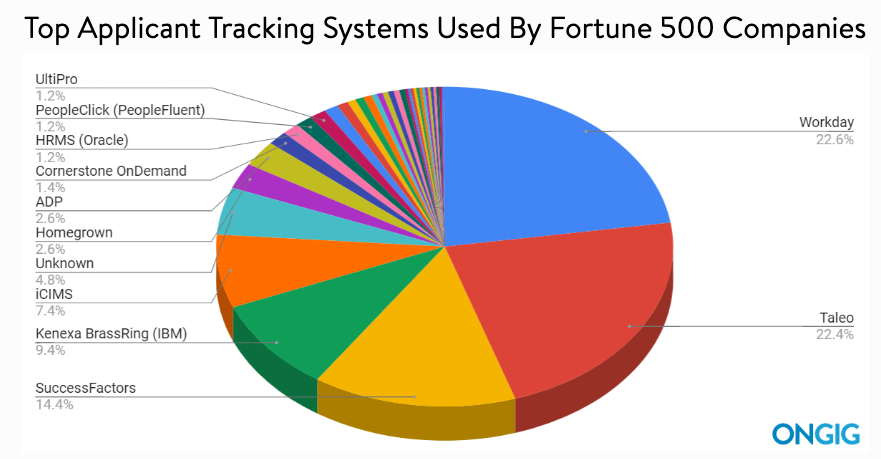One of my favorite reports of the year, from one of the guys I really respect in the industry, Rob Kelly at Ongig, the Top ATS Systems Used by the Fortune 500 was released last week. Now, Rob has been releasing ATS use data for a few years across all segments, SMB, Large, Enterprise. This time around he stuck with just the Fortune 500, because, quick frankly, it’s fairly easy to know, exactly, what every one of the Fortune 500 is using.
Here’s what he found in 476 (Yes, they couldn’t determine 24):
Big takeaways:
– The growth of Workday, in the talent acquisition space, isn’t shocking, but it is concerning. It speaks to HR’s, and more specifically Talent Acquisitions, lack of voice in picking their own technology. It’s very rare, even amongst the Fortune 500 clients using Workday Recruit to find a TA leader who would tell you they actually had a say in choosing the technology they are being forced to use. Not a criticism of Workday, just a fact of the reality of what is happening.
– Workday Recruit and getting it to not just work, but thrive, should be something TA tech vendors are trying to figure out, and it would help if Workday would welcome in the industry on this work. Too many TA leaders and their organizations need this help, desperately. I’m not a Workday hater. I hear from my Finance friends, my Payroll friends, and my HR friends that Workday is great, solid tech. I truly want them, and anyone in our space supporting TA, to get Great!
– Taleo market share is shrinking and Oracle has been slow to market with a Taleo replacement. I expect we’ll see start to see a push from them in 2020, but it might be too late. BUT, like Workday, Oracle, SAP, etc. will have the advantage of shoving down their recruiting tech in suite form onto unsuspecting TA leaders, who aren’t in the know about what’s going on with technology in their organizations.
– There are better ATSs on the market than Workday, Taleo, and Successfactors by giant margins. Yet, they take up most of the enterprise market share. My Enterprise HR and TA friends will tell me that the enterprise ‘suite’ is a necessary evil they can’t get away from. I will continue to argue there is no real reason to have your employee data (HRIS) and your candidate data (ATS) in the same database. Any basic Business Intelligence tool can pull the data you need from either one of these systems to give you anything you might need in combining those two data sets. Which, in reality, is rare.
– The evolution of the Talent Acquisition/Recruiting Platforms/Marketplaces being built out by many high performing ATSs (Greenhouse, SmartRecruiters, Jobvite, iCIMS, etc.) will be a competitive advantage for organizations that use it, over the enterprise HRIS recruiting modules, and it won’t even be close. But, the reality is, F500 organizations have brands that probably make this somewhat negligible in the short-term.
– Wait, people are still using Brassring?


I completely agree that the growth of Workday speaks to talent acquisition’s lack of voice in chasing a technology. In my experience, HR leaders adore Workday for core human capital management, but talent acquisition find it lacking in the recruiting space. Yet, HR leadership seems to win this tug-of-war, as managing and integrating multiple systems is less desirable among top-level leaders.
Thanks!
Adrian
Fully agree with the ‘necessary evil’ perception of large enterprises. They chose tried & tested over more agile ATS Platforms, despite a massive cost differential.
Also, User experience is gaining prominance. Customization, simplicity of usage, minimal training effort, intuitive action, etc. and that’s a key reason behind diminishing market shares of old world behemoths like Taleo & Successfactors.
Third to last point is great – too many TA Leaders are going with ATS that integrate or are a module in their ERP rather than looking at a best-in-class solution. I think part of it is laziness (not wanting to look at vendors), while part of it is buy-in (if the rest of the business is using an ERP, easy to get buy-in to go with that solution).
What does it say about the state of Fortune 500 companies’ technology. They are following a brand without a good understanding of what’s good for their users. They are inefficient behemoths too afraid to change.